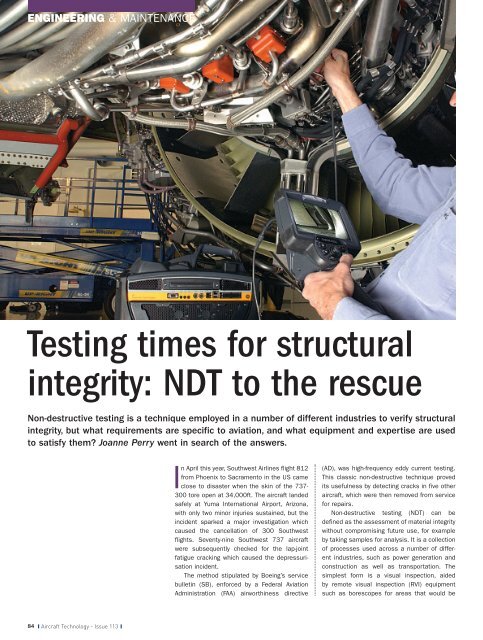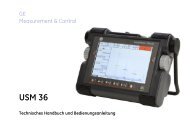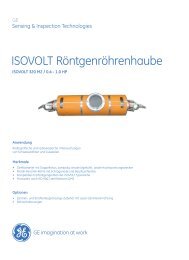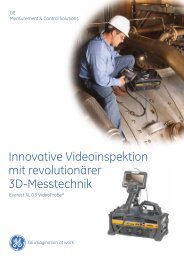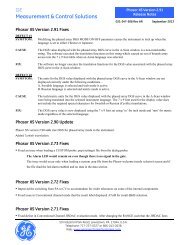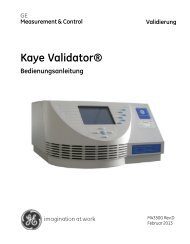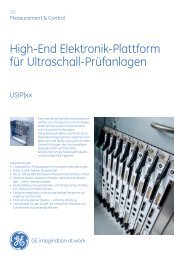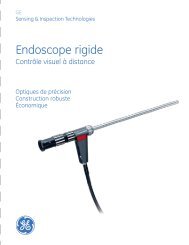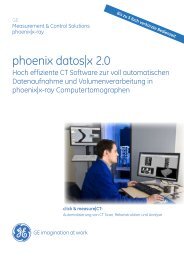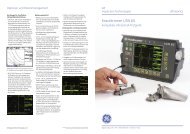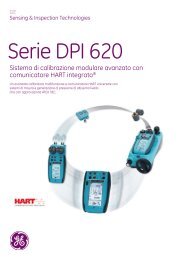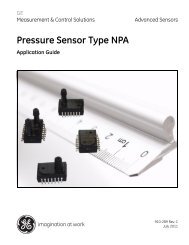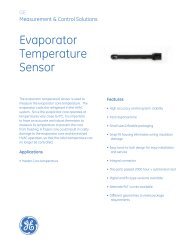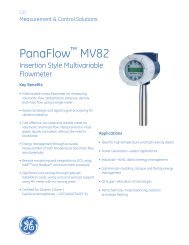Testing times for structural integrity - GE Measurement & Control
Testing times for structural integrity - GE Measurement & Control
Testing times for structural integrity - GE Measurement & Control
You also want an ePaper? Increase the reach of your titles
YUMPU automatically turns print PDFs into web optimized ePapers that Google loves.
ENGINEERING & MAINTENANCE<br />
<strong>Testing</strong> <strong>times</strong> <strong>for</strong> <strong>structural</strong><br />
<strong>integrity</strong>: NDT to the rescue<br />
Non-destructive testing is a technique employed in a number of different industries to verify <strong>structural</strong><br />
<strong>integrity</strong>, but what requirements are specific to aviation, and what equipment and expertise are used<br />
to satisfy them? Joanne Perry went in search of the answers.<br />
84 ❙ Aircraft Technology - Issue 113 ❙<br />
In April this year, Southwest Airlines flight 812<br />
from Phoenix to Sacramento in the US came<br />
close to disaster when the skin of the 737-<br />
300 tore open at 34,000ft. The aircraft landed<br />
safely at Yuma International Airport, Arizona,<br />
with only two minor injuries sustained, but the<br />
incident sparked a major investigation which<br />
caused the cancellation of 300 Southwest<br />
flights. Seventy-nine Southwest 737 aircraft<br />
were subsequently checked <strong>for</strong> the lap-joint<br />
fatigue cracking which caused the depressurisation<br />
incident.<br />
The method stipulated by Boeing’s service<br />
bulletin (SB), en<strong>for</strong>ced by a Federal Aviation<br />
Administration (FAA) airworthiness directive<br />
(AD), was high-frequency eddy current testing.<br />
This classic non-destructive technique proved<br />
its usefulness by detecting cracks in five other<br />
aircraft, which were then removed from service<br />
<strong>for</strong> repairs.<br />
Non-destructive testing (NDT) can be<br />
defined as the assessment of material <strong>integrity</strong><br />
without compromising future use, <strong>for</strong> example<br />
by taking samples <strong>for</strong> analysis. It is a collection<br />
of processes used across a number of different<br />
industries, such as power generation and<br />
construction as well as transportation. The<br />
simplest <strong>for</strong>m is a visual inspection, aided<br />
by remote visual inspection (RVI) equipment<br />
such as borescopes <strong>for</strong> areas that would be
ENGINEERING & MAINTENANCE<br />
Top and above: Technicians per<strong>for</strong>m<br />
thermographic NDT.<br />
86 ❙ Aircraft Technology - Issue 113 ❙<br />
inaccessible without disassembly. However,<br />
this method is only useful <strong>for</strong> superficial problems<br />
and is heavily dependent upon the skill<br />
and dedication of the technician.<br />
The American Society <strong>for</strong> Nondestructive<br />
<strong>Testing</strong> (ASNT) lists six basic methodological<br />
categories: mechanical and optical; penetrating<br />
radiation; electromagnetic and electronic; sonic<br />
and ultrasonic; thermal and infrared; and chemical<br />
and analytical testing. The ASNT supplements<br />
these with image generation and signal<br />
image analysis. Varieties of NDT too numerous<br />
to mention branch out from each main type.<br />
In aviation, NDT is used not only during<br />
post-incident investigations as in the case of<br />
Southwest, but during component manufacture,<br />
to preclude flaws, and in the maintenance<br />
and repair of both airframes and engines to<br />
detect not only cracks but disbonding, corrosion,<br />
scratches and other problems or damage.<br />
Steven Shepard, president of Thermal Wave<br />
Imaging (TWI), based in Michigan, US, explains<br />
some of the requirements of aerospace NDT:<br />
“Speed and economy are essential <strong>for</strong> NDT<br />
equipment in almost any industry in today’s<br />
economy. However, aviation requires a higher<br />
degree of accuracy and reliability than most”.<br />
The Southwest incident provides a timely example<br />
of the important role NDT has to play in verifying<br />
the airworthiness of aircraft and the<br />
safety of passengers. Mike Fortman, president<br />
of NDT service provider Aerotechnics in<br />
Minnesota, US, says that “nearly all aircraft<br />
components require some sort of special attention<br />
or detailed inspection”. With a constant<br />
drive to reduce aircraft weight because of its<br />
impact on fuel burn, parts are called upon to<br />
per<strong>for</strong>m their respective functions at high load<br />
relative to material strength. They must furthermore<br />
withstand the stress created by repeated<br />
loading and unloading of the aircraft, temperature<br />
and pressure changes, and other atmospheric<br />
conditions such as lightning strikes.<br />
The need <strong>for</strong> NDT does, however, vary<br />
across the aircraft. As Mark Ginn, chief inspector<br />
at Delta TechOps, explains, many components<br />
“require special attention when receiving<br />
NDT as a result of their criticality to safe flight”,<br />
whether they are located in the engines, landing<br />
gear or airframe. Albrecht Maurer, senior
product manager testing systems, at <strong>GE</strong><br />
Sensing & Inspection Technologies agrees that<br />
the difference in safety requirements is the<br />
main factor in determining the intensity of the<br />
NDT which is conducted. “Primary structures<br />
receive more NDT attention than secondary or<br />
tertiary structures,” he states.<br />
Shepard adds that, in an additional complication<br />
<strong>for</strong> the aerospace industry, many aviation<br />
inspections “involve large areas in which the<br />
component construction may vary considerably”.<br />
A central aspect of this variation stems from the<br />
material used in manufacture, but further considerations<br />
are the nature of the suspected flaw<br />
and the conditions of inspection, says Philippe<br />
Boiteux, COO managing director of NDT Expert,<br />
an NDT solutions provider based in France. The<br />
latter include the expertise of the company and<br />
technicians concerned, and whether it is a manufacturing<br />
or maintenance operation per<strong>for</strong>ming<br />
the NDT. Maurer points out that the choice of<br />
NDT technique is also governed by manufacturer<br />
and certifier approvals.<br />
MRO provider Delta TechOps maintains a<br />
broad portfolio of NDT capabilities in order to<br />
balance out the strengths and weaknesses of<br />
the different methods: eddy current; magnetic<br />
FACT: Max rotational<br />
speed 2,550 rpm<br />
particle; fluorescent penetrant; ultrasonic; radiographic;<br />
and infrared testing. As an example,<br />
Ginn explains that the magnetic particle<br />
method, which involves the dusting of a magnetised<br />
surface with iron particles to highlight<br />
anomalies, cannot be applied to non-ferrous<br />
materials. In addition, although magnetic particle<br />
NDT can be used to identify subsurface<br />
defects, its effectiveness decreases with depth.<br />
It also requires the removal of paint from the<br />
test surface. Meanwhile, eddy current testing,<br />
which involves the generation of electrical currents<br />
by a changing magnetic field and the noting<br />
of any flow disruption, cannot be per<strong>for</strong>med<br />
on non-metallic materials such as composites.<br />
NDT <strong>for</strong> composites<br />
“Infrared (thermal imaging), ultrasonic testing<br />
(resonance, low frequency pitch-catch, pulse<br />
echo, through transmission), and radiography (digital<br />
or film x-ray) need to be used to find flaws in<br />
composite materials,” according to Fortman. <strong>GE</strong><br />
Sensing & Inspection’s Maurer believes that <strong>for</strong><br />
such applications ultrasonic testing (UT) “is the<br />
most reliable method with least technical restriction,<br />
i.e. minimum/maximum thickness and complexity<br />
of structure”.<br />
ENGINEERING & MAINTENANCE<br />
Many aviation inspections<br />
involve large areas in which<br />
the component construction<br />
may vary considerably.<br />
— Steven Shepard, president,<br />
TWI<br />
AIRCRAFT TECHNOLOGY’S<br />
annual publication <strong>for</strong> the<br />
aero-engine professional<br />
JUST FACT, NO SPIN<br />
Engine Yearbook 2012 Deadlines:<br />
Ad Booking: October 10th 2011 Ad Copy: October 17th 2011 Publishing: November 7th 2011<br />
If you want to promote in the 2012 edition of The Engine Yearbook, or if you would like any other in<strong>for</strong>mation, please<br />
contact any of the Sales Team: Simon Barker, Alan Samuel or Anthony Smith on Tel: +44 (0) 207 579 4845/ -46/ -75 or via<br />
Email: simon.barker@ubmaviation.com or alan.samuel@ubmaviation.com or anthony.smith@ubmaviation.com<br />
❙ Aircraft Technology - Issue 113 ❙<br />
87
ENGINEERING & MAINTENANCE<br />
Top: Eddy current NDT can only be applied to<br />
metallic materials.<br />
Inset: “Bondtracer” from <strong>GE</strong> Sensing &<br />
Inspection Technologies.<br />
88 ❙ Aircraft Technology - Issue 113 ❙<br />
In UT, both geometric surfaces and internal<br />
<strong>integrity</strong> can be analysed by the transmission<br />
of high-frequency sound waves into the test<br />
material. Resonance testing in its most rudimentary<br />
<strong>for</strong>m consists of a “tap” test, which is<br />
what the name suggests, but is computerised<br />
at the highest levels. In through transmission,<br />
a transmitter is positioned on one side of the<br />
test material and a receiver on the other, while<br />
pulse echo is a single-sided technique <strong>for</strong> less<br />
accessible areas, and in the pitch-catch<br />
method the transmission occurs at an angle<br />
and is useful <strong>for</strong> the testing of non-linear<br />
objects. Linear array UT involves a single<br />
source of transmission, while a more complex<br />
and more commonly used version with multiple<br />
pulsing elements — phased array — creates a<br />
kind of steerable “searchlight” <strong>for</strong> inspection.<br />
Newly launched NDT products in the UT category<br />
include the “Bondtracer” unveiled by <strong>GE</strong> in<br />
May this year in collaboration with Boeing. This<br />
is a portable composites inspection tool which<br />
is designed to enable mechanics to assess<br />
minor impact damage at an airport gate. The<br />
quick feedback produced by “Bondtracer” determines<br />
whether an aircraft is fit to fly or requires<br />
further investigation and repair.<br />
In radiographic testing (RT), gamma or X-rays<br />
— which one depends upon the thickness of<br />
the material in question — are directed through<br />
the test object onto a film, which produces a<br />
shadowgraph depicting internal features. As in<br />
the well-known medical application, variations in<br />
density are represented by lighter and darker<br />
areas. Radiography has the advantage of removing<br />
disassembly requirements, but brings with it<br />
the disadvantage of safety concerns. Owing to<br />
the hazardous nature of X-rays and radioactive<br />
isotopes such as iridium 192, which produce<br />
gamma rays, extra precautions must be taken<br />
when using this technique, such as protective<br />
equipment and warning systems.<br />
Shepard asserts that thermography is also<br />
a good option <strong>for</strong> composites, because “the<br />
cost of a large-scale thermography system is<br />
significantly less than the alternatives”. As a<br />
result, “many companies have replaced C-scan
ENGINEERING & MAINTENANCE<br />
Top: NDT is per<strong>for</strong>med on an engine.<br />
Above: An NDT employee analyses results by<br />
computer.<br />
90 ❙ Aircraft Technology - Issue 113 ❙<br />
[UT] systems with thermography”. In thermography,<br />
the test material is heated so that the<br />
temperature decay can be observed over time,<br />
with <strong>structural</strong> anomalies disrupting normal<br />
cooling. However, Shepard notes that the<br />
unprocessed images from the standard<br />
infrared camera used to detect the thermal patterns<br />
“are not sufficient <strong>for</strong> many aviation NDT<br />
requirements”.<br />
TWI there<strong>for</strong>e uses a thermographic signal<br />
reconstruction (TSR) processing method which<br />
analyses the time evolution of each pixel,<br />
enabling not only the identification of anomalies<br />
but quantitative measurement of thickness, thermal<br />
diffusivity or porosity. He says this effectively<br />
allows a user to “drill down” into the test item.<br />
“This combination of fast area coverage and the<br />
ability to ‘self-validate’ image results using time<br />
response is a unique advantage of thermography,”<br />
he states. Other advantages include a fair<br />
tolerance of non-planar geometries, surface<br />
characteristics and ambient conditions. “The<br />
most fundamental limitation is the one imposed<br />
by the physics of diffusion, which requires that<br />
the diameter of a subsurface feature is larger<br />
than its depth,” states Shepard.<br />
Maurer says that, in summary, the NDT<br />
methods which can be used <strong>for</strong> composites are<br />
“ideal to detect lack of bonding (delamination)<br />
as well as porosity over the whole area of each<br />
component without impacting its properties”.<br />
This is because composites “rely strongly on<br />
the perfect bonding between individual layers<br />
and on absence of pores which may develop<br />
during the hot curing process”.<br />
Flaw characteristics and<br />
inspection conditions<br />
The properties of material flaws which<br />
impact on NDT include size, depth and accessibility,<br />
says Fortman. He gives the example of<br />
rotating engine parts such as turbine blades<br />
and discs, which may contain very small<br />
defects that require the use of special penetrants<br />
and/or automated scanning. In penetrant<br />
testing (PT), a simple NDT method based<br />
on the capillary action of liquids, a solution of
visible or fluorescent dye is applied to the test<br />
object, be<strong>for</strong>e the excess solution is removed<br />
to highlight any breaks in the surface. A developer<br />
is used to draw the penetrant out of the<br />
defects. Visible dyes rely on colour contrast<br />
between the penetrant and the developer,<br />
while fluorescent dyes are activated by ultraviolet<br />
light. However, as Ginn points out, a key<br />
drawback is that penetrants can only detect<br />
superficial discontinuities. The chemicals may<br />
also damage composite materials. Care must<br />
be taken in any case to properly clean off the<br />
penetrant, or risk misleading results. This<br />
method, like magnetic particle testing, also<br />
necessitates the removal of paint from the<br />
test material.<br />
As regards the differences between NDT <strong>for</strong><br />
manufacturing and maintenance applications,<br />
Maurer explains: “Parts with MRO-testing<br />
requirements demand instant image output<br />
rather than time consuming scanning<br />
processes, e.g. impact analysis through<br />
shearography [optical NDT], remote visual<br />
inspection and in special cases UT testing with<br />
portable scanners.” TWI, <strong>for</strong> example, provides<br />
large-scale thermographic systems <strong>for</strong> manufacturing<br />
contexts and portable/ handheld<br />
products <strong>for</strong> in-service use. There is some<br />
crossover, however. <strong>GE</strong>’s Phasor XS and DM<br />
phased array UT products can be used <strong>for</strong> volumetric<br />
inspection during both manufacture<br />
and maintenance, as can the company’s range<br />
of RVI equipment.<br />
In light of the pros and cons of different<br />
NDT methods, it can be necessary to use multiple<br />
techniques during inspection. For example,<br />
the emerging NDT technique of process<br />
compensated resonance testing (PCRT) offers<br />
a high degree of objectivity through the compilation<br />
of statistical data — but relies on a<br />
known sample set to establish basic parameters.<br />
In this method, samples of defective and<br />
defect-free parts identified by destructive<br />
analysis or another NDT technique are used to<br />
build a customised software algorithm, based<br />
on the contrast between a series of natural frequencies<br />
or resonant responses from the two<br />
groups. As Greg Weaver, director of operations<br />
at Vibrant Corporation in New Mexico, US,<br />
explains: “The software is defining not only the<br />
absolute response differences, but more<br />
importantly the relationship difference across<br />
multiple responses.” The system can be<br />
“taught” to recognise acceptable and unacceptable<br />
differences between components of<br />
the same type, compensating <strong>for</strong> the unintentional<br />
variation generated by even the most<br />
modern manufacturing processes.<br />
Like other NDT types, PCRT possesses a<br />
mixture of good and bad points. On the negative<br />
side, although PCRT can detect a decline in<br />
<strong>structural</strong> <strong>integrity</strong>, it does not specify the defect<br />
type or location as would magnetic particle testing<br />
and phased array UT. However, Weaver says<br />
the technique does challenge FP and X-ray NDT,<br />
and at a comparable cost. One of the key advantages,<br />
he explains, is that PCRT can detect<br />
more than one defect type, internally and externally,<br />
in a single inspection. Additionally, it is<br />
“the only NDT method that can detect metallurgical<br />
issues such as alloy overtemp and intergranular<br />
attack”. The inspection time is also<br />
impressive — between four and six seconds <strong>for</strong><br />
the resonance test itself. Importantly, PCRT can<br />
be applied to both metallic and non-metallic<br />
parts including composites, during either manufacture<br />
or maintenance processes. “A PCRT<br />
test at the front of an MRO receiving process<br />
could save companies an enormous amount of<br />
time and money,” states Weaver. “The same<br />
goes <strong>for</strong> blade manufacturing, where PCRT can<br />
not only be used as an inspection tool, but also<br />
as a process control measurement.”<br />
In aviation, PCRT is mainly used <strong>for</strong> turbine<br />
components, including solid and hollow turbine<br />
blades, silicon nitride bearing elements and <strong>for</strong>gings/castings.<br />
Weaver believes that PCRT<br />
“should become a dominant inspection in the<br />
ENGINEERING & MAINTENANCE<br />
<strong>GE</strong>’s “Phasor XS” phased array NDT solution.<br />
❙ Aircraft Technology - Issue 113 ❙<br />
91
ENGINEERING & MAINTENANCE<br />
PCRT systems can recognise acceptable and unacceptable differences between components of the same type.<br />
Parts such as bolts may be tested by NDT.<br />
92 ❙ Aircraft Technology - Issue 113 ❙<br />
turbine blade world” and that it might be<br />
included in most OEM standard practice manuals<br />
within five years, bearing in mind the difficulty<br />
of making predictions. Delta TechOps received<br />
FAA approval <strong>for</strong> PCRT in September 2010, and<br />
Ginn views the technique as “an important capability<br />
in years to come and an important part of<br />
the Delta TechOps NDT portfolio”.<br />
The latest on NDT<br />
“Even conventional techniques are permanently<br />
moving on,” Boiteux observes. One of<br />
the biggest sources of change in the NDT business<br />
is the trend in airframe manufacturing<br />
toward greater proportions of composite materials.<br />
Jeff Stetson, senior product manager,<br />
ultrasonics, at <strong>GE</strong>, says that on the UT side,<br />
“composite airframes are driving some<br />
changes in equipment”. According to Boiteux,<br />
the increase over the past decade has led<br />
to an expansion of UT, thermographic and<br />
shearographic capabilities. As the composite<br />
level rises, “NDT methods such as ultrasonics,<br />
radiography, and infrared inspections become<br />
more valid,” notes Fortman. “Established methods<br />
such as penetrant testing, magnetic particle<br />
testing, and eddy current are nearly<br />
obsolete or unusable on composite materials”.<br />
At Delta TechOps, Ginn has witnessed the<br />
growing importance of UT, “with ultrasound<br />
being the method of choice <strong>for</strong> many composites”,<br />
but also a similar trend in eddy<br />
current testing. He adds that eddy current<br />
NDT, UT, RT and infrared testing have all “benefited<br />
from technological advancements over<br />
the last few years”.<br />
Referring to NDT as a whole rather than<br />
composites-focused NDT, Ginn says the use of<br />
mature methods such as magnetic particle<br />
testing and FP “has remained fairly constant”.<br />
Stetson adds that <strong>for</strong> engine inspections one<br />
of the most noteworthy technological advancements<br />
has been the “huge transition<br />
from film to digital RT”, <strong>for</strong> which <strong>GE</strong> has<br />
developed products such as the DXR 250P, a<br />
digital and portable RT solution <strong>for</strong> on-wing<br />
inspections.<br />
There is clearly a wealth of NDT equipment<br />
and expertise on the market. If the near-disaster<br />
of flight 812 is anything to go by, it is more<br />
a question of ensuring that these services are<br />
called upon as appropriate. Although eddy current<br />
testing detected cracks in a number of<br />
Southwest aircraft during the fleet-wide investigation,<br />
prior to the incident only visual inspections<br />
were required <strong>for</strong> the 737 Classic<br />
serving the flight. Nor was this the first such<br />
incident involving a Southwest aircraft; something<br />
of a track record had even led to a $7.5m<br />
settlement in 2009 <strong>for</strong> missed fuselage<br />
inspections. It seems safe to say that a little<br />
more non-destructive testing on the ground<br />
could prevent a whole lot more destruction in<br />
the air. ■


